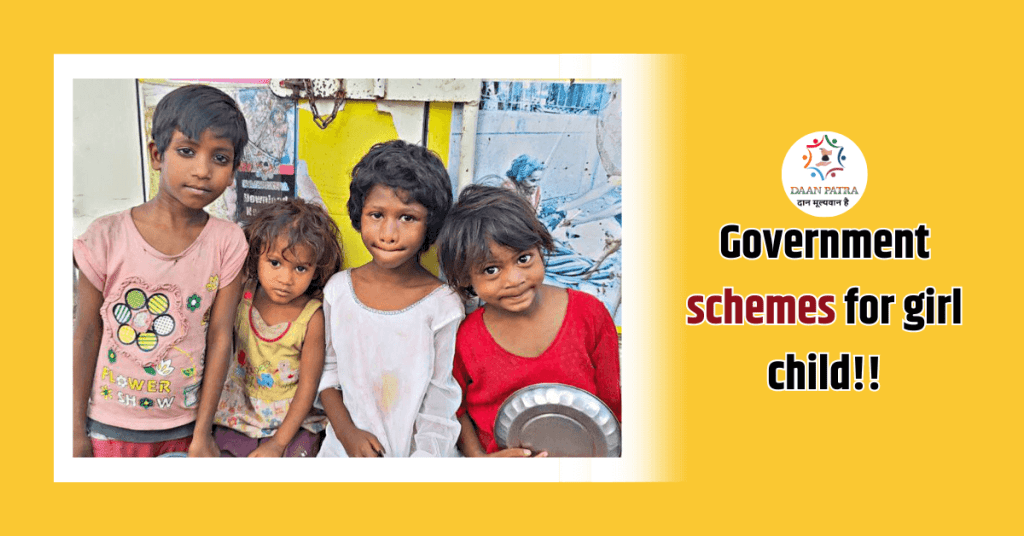Strong government schemes for girl children that expressly address the issues faced by females have opened the way for gender equality and female empowerment in India. The country’s dedication to the welfare of girls can be seen in many laws and initiatives prioritizing their education, health, and general development. In this thorough investigation, we dive into important government programs meant to encourage and assist females nationwide.
Top government schemes for girl children in India
Sukanya Samriddhi Yojana (Scheme):
The great Sukanya Samriddhi Yojana and the Indian government schemes for women’s education want to push consistent savings from expenses associated with marriage, schooling, and having a girl child. For a girl under 10, this savings plan is like receiving a financial present if she has parents or guardians. A bright future is ensured for females by opening a Sukanya Samriddhi Yojana account, which offers competitive interest rates and tax benefits. Any parent or legal caregiver of a girl child under the age of ten is eligible to participate in the program, but there are a few straightforward requirements. The program provides a disciplined and safe means to save money for important life events like marriage and education. Through Sukanya Samriddhi Yojana, the government wants to lower the cost of homes and encourage the girls to save money for the future.
Advantages
- Encourages disciplined savings for a girl child’s future.
- Offers attractive interest rates and tax benefits.
- Specific focus on marriage and education expenses.
Disadvantages
- Restricted to girls under the age of 10.
- Withdrawal restrictions may limit flexibility in certain situations.
Pradhan Mantri Suraksha Bima Yojana (Scheme)
Pradhan Mantri scheme for girl children is a program that aims to protect people and their health and well-being, even if it is not, especially for women. The best scheme for girl children acts as a haven for participants, offering them affordably priced coverage for untimely death and incapacity, guaranteeing their financial security. By shielding their funds from unknown issues, families can better secure their daughters’ futures with the aid of this program. The PMSBY eligibility requirements are very inclusive, covering everyone from the age of 18 to 70. Families can take advantage of this insurance system because of its equality, which guarantees that various people can profit from it. The government’s dedication to improving money stability for all, particularly for the benefit of girls within the larger scheme of society, is shown by the Pradhan Mantri Suraksha Bima Yojana.
Advantages
- Provides affordable insurance coverage for unforeseen events.
- Inclusive eligibility criteria (18 to 70 years old).
- Ensures financial security for families, including girls.
Disadvantages
- Not exclusively designed for women or girl children.
- Limited coverage scope compared to comprehensive insurance plans.
Beti Bachao, Beti Padhao Scheme
In addition to lowering child and sex ratios, the creative Beti Bachao, Beti Padhao program seeks to increase women’s educational attainment. This project is a call to action, asking people to remember and celebrate girls’ births and educations as they do for boys. The Beti Bachao Beti Padhao scheme for girl children in India is open to all societal parts, with no eligibility restrictions, highlighting the importance of empowering girls everywhere.
By increasing knowledge and supporting positive views toward the birth and growth of girls, the program seeks to end sexism. It creates an atmosphere in which girls have equal access to learning and development opportunities. Rather than being just a government project, Beti Bachao, Beti Padhao is an unofficial group that seeks to smash stereotypes and ensure a more equal and gender-sensitive future.
Advantages
- Addresses declining child-sex ratio.
- Promotes female education.
- Social movement challenging gender stereotypes.
Disadvantages
- Relies heavily on societal change, not a strict government policy.
- Challenges in measuring immediate impact due to the cultural shift required.
Pradhan Mantri Matru Vandana Yojana (Scheme)
A major initiative called the Pradhan Mantri Matru Vandana Yojana aims to empower women during the vital postpartum and pregnancy years. It assists all expecting and nursing moms, even those with permanent work, and has a significant positive impact on the health and well-being of newborn girls. Pregnant and nursing women meet the qualifying requirements for PMMVY, and among the benefits is financial support for the first live birth. By supporting moms in affording proper food and medical treatment, this support hopes to improve the health and development of the girl child. The government’s acceptance of the role that the health of mothers plays for future generations’ well-being including the empowerment of girls is reflected in Pradhan Mantri Matru Vandana Yojana.
Advantages
- Offers financial support to women undergoing pregnancy and childbirth.
- Places a strong emphasis on maternal health for the benefit of both moms and daughters.
- Inclusive eligibility for expecting and nursing mothers.
Disadvantages
- Limited to financial support for the first live birth.
- Challenges in ensuring widespread awareness and participation.
The National Girls’ Secondary Education Incentive Scheme
A specialized program called the State Incentive Scheme for Secondary Education for Girls is designed for girls enrolled in government-aided schools in grades nine and ten. The main goal of this program is to encourage girls to study and go to high school. The government hopes to remove difficulties that might prevent girls from studying higher education beyond primary school by offering cash rewards.
The program’s eligibility requirements are simple: Females attending state-aided schools in grades 9 and 10 are eligible. Girls and their families are motivated by financial incentives that support the idea that education is not only important but also rewarding. Through the project, girls are offered equal opportunities to get an education and develop a mindset that values and supports what they learn.
Advantages:
- Government Schemes for Girl Child encourages girls to enroll and attend high school.
- Provides cash rewards to promote education.
- Simple eligibility criteria for government-aided school enrollment.
Disadvantages
- Limited focus on higher education beyond secondary school.
- May need to address broader systemic issues affecting girls’ education.
Conclusion:
In conclusion, the previously noted Indian government schemes for women’s education for girls demonstrate not only the Indian government’s commitment to creating a society where women are more varied and powerful but also a thorough approach to addressing every issue that girls encounter. Every initiative demonstrates an advanced knowledge of the complicated nature of gender-based issues by providing a focused response to particular challenges.
Sukanya Samriddhi Yojana, a pillar of financial planning, provides families with secure, orderly funds to support their girl child, education, and marriage. The Pradhan Mantri Suraksha Bima Yojana acts as a safety net to ensure people’s well-being, especially girls, and to provide an emergency fund in case of unforeseen events. Beyond the rules, Beti Bachao, Beti Padhao grows into a social movement that challenges accepted beliefs and promotes equality for girls from birth to graduation. This program demonstrates a dedication to altering societal views and enhancing a setting where each girl and her potential are acknowledged and appreciated. In addition to offering financial support, the Pradhan Mantri Matru Vandana Yojana highlights the value of maternal health and how important it is to both mothers’ and their daughters’ well-being. This program supports mothers during breastfeeding and pregnancy to ensure a healthy start for the female child. In addition, females are encouraged to pursue secondary education beyond primary school via the National Scheme of Incentives to females for Secondary Education. The government wants to remove difficulties and give girls equal chances by offering financial incentives and highlighting the importance and benefits of education. Together, these initiatives contribute to the continuous change of India’s social structure as they develop. These government schemes for girl children go beyond legal actions; they represent a group effort to remove walls, fight mistakes, and build a future in which every girl has the chance to succeed. The best scheme for girl children sets a strong example for other countries hoping to create a society that genuinely empowers and celebrates the potential of its girls by adopting such a thorough and focused approach.
Frequently Asked Questions (FAQ):
Q1: To whom is Sukanya Samriddhi Yojana open to applicants?
A girl who is younger than ten years old can open an account under the Sukanya Samriddhi Yojana alongside her parents or guardians.
Q2: Could you explain the Pradhan Mantri scheme for girl children?
People between the ages of 18 and 70 can apply for accident and disability insurance through the Pradhan Mantri Suraksha Bima Yojana (PMSBY), which offers financial security in unwanted circumstances.
Related Posts:
What are Child Rights in India
Top 10 Advantages of Girl Child Education in India
What is Child-Centered Education


I have a great command of sophisticated language and literature because I am an artist at heart as well as a writer by profession. I am able to constantly produce work of a high quality because of my knowledge. I’m well-known for my versatility and am an excellent writer of both creative and technical content. To write content that is both entertaining and customized, I take the approach of getting to know the interests and preferences of my targeted audience.

